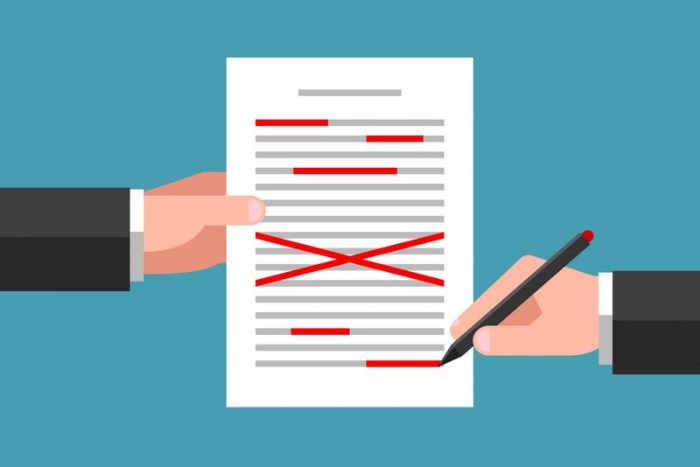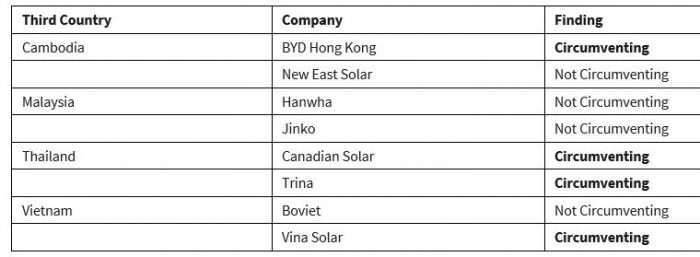
The preliminary decision is in, and the U.S. Department of Commerce is issuing a determination of circumvention in Auxin’s antidumping duty (AD) and countervailing duty (CVD) case regarding solar cells and modules from Cambodia, Malaysia, Thailand and Vietnam. But there are several companies with operations in these companies that received findings of “not circumventing,” and Commerce created a new module certification test that could be another path for modules produced in this region to avoid new tariffs.
A finding of circumvention felt inevitable, especially after Commerce’s May 2 memo that noted if Chinese-origin wafers were supplied by a Chinese manufacturer with a company-specific rate, then “the cash deposit rate for the relevant imports from the third country will be equal to that Chinese manufacturer’s and/or exporter’s company-specific rates.”
It appears the May 2 memo held true. This preliminary decision (minus the companies listed as “not circumventing”) applies to solar cells and modules made in Southeast Asia using Chinese wafers. China still has 96 percent of the global wafer supply, but the second largest region is SE Asia, and a lot of new wafer supply is set to come online.
We also said about the May 2 memo that “requiring company-specific certifications of origin means that Commerce is going to investigate the supply chain in greater detail than it has in prior circumvention investigations” — which Commerce definitely plans to do in this decision via a new Applicable Entries certification for imports from this region (listed in Appendix IV). More on this in a minute.
The circumvention findings for notable companies that responded to Commerce’s inquiry:

A finding of circumvention means Commerce has determined the processing work that these companies were doing in their facilities within these countries was “minor.” (We’ve written previously how, based on previous decisions, solar cell production meets the substantial work criteria and won’t rehash that here).
In addition to that list, 22 companies in Malaysia, Thailand and Vietnam did not respond to Commerce’s request for information, which also results in a finding of circumvention. Chinese wafers from these smaller companies that do not have a base of operations in Southeast Asia or their own duty rate will be hit hardest of all because they will be assessed the China-wide duty of 240 percent.
A final determination should be issued May 1, 2023.
Remember though, a Presidential Proclamation issued on June 6, 2022, exempted solar module and cell imports from these four countries from new tariffs until June 2024.
“The only good news here is that Commerce didn’t target all imports from the subject countries,” stated Abigail Ross Hopper, president and CEO of the Solar Energy Industries Association (SEIA). “Nonetheless, this decision will strand billions of dollars’ worth of American clean energy investments and result in the significant loss of good-paying, American, clean energy jobs. While President Biden was wise to provide a two-year window before the tariff implementation, that window is quickly closing, and two years is simply not enough time to establish manufacturing supply chains that will meet U.S. solar demand.
Six components beyond wafers listed to watch
Beyond wafers, this decision highlights six PV panel components: silver paste, aluminum frames, glass, backsheets, ethylene vinyl acetate sheets and junction boxes. Commerce will be looking to see the country of origin of those six components too – and if a module produced in Southeast Asia with China wafers includes at least four of those components outside of China, then those modules are not applicable to the new tariffs. Here is the language of that section. I’ve bolded part for emphasis:
(B) modules, laminates, and panels consisting of crystalline silicon photovoltaic cells, subject to the exclusions for certain panels in the scope of the underlying orders, whether or not partially or fully assembled into other products, that were produced in Cambodia, Malaysia, Thailand, or Vietnam from wafers produced in China and where more than two of the following components in the module/laminate/panel were produced in China: (1) silver paste; (2) aluminum frames (3) glass; (4) backsheets; (5) ethylene vinyl acetate sheets; and (6) junction boxes.
If modules, laminates, and panels consisting of crystalline silicon photovoltaic cells do not meet both of the conditions in item (B) above, then these circumvention inquiries do not cover the modules, laminates, and panels, or the crystalline silicon photovoltaic cells within the modules, laminates, and panels, even if those crystalline silicon photovoltaic cells were produced in Cambodia, Malaysia, Thailand, or Vietnam from wafers produced in China. Wafers produced outside of China with polysilicon sourced from China are not considered to be wafers produced in China for purposes of these circumvention inquiries.
Takeaways
Qcells and Jinko are not subject to duties. It didn’t really make sense why Qcells was caught up in this to begin with. China-based Jinko, one of the largest producers in the world, was in a more precarious position but will not be subject to new duties.
Commerce came at this with more of a scalpel than a hammer, carving out the company-specific operations in specific countries, and has (at least based on my reading of the phrase bolded above) also allowed for a workaround for other SE Asia modules with Chinese wafers that source the other components elsewhere. It is not the decision the Solar Energy Industries Association (SEIA) and many leaders of the industry wanted. But it is not the harshest decision that they feared either.
— Solar Builder magazine
Leave a Reply
You must be logged in to post a comment.